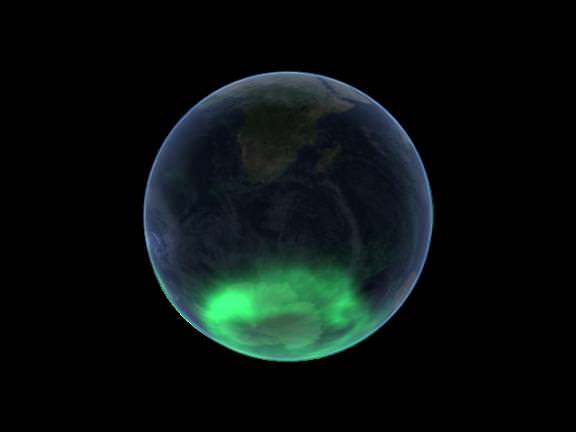[/caption]
The southern lights, or aurora australis, is the southern hemisphere counterpart to the northern lights, or aurora borealis. They are one of nature’s most spectacular light shows, a sorta reward to the people who live that far south, in return for all the cold weather.
Because the southern lights most often occur in a band, or ring, more-or-less centered on the south magnetic pole (the auroral zone, radius approx 2,500 km), and because there is hardly any land in this band (and what little there is, no one lives there!), far fewer people have seen the southern lights than their northern siblings. However, they are sometimes seen in New Zealand (especially the South Island), Tasmania, in the far south of Chile and Argentina, etc. Most often they appear as sheets of color (mostly green, but sometimes other colors too, like red, or purple), on the southern horizon.
The southern lights are caused, ultimately, by energetic particles – mostly electrons – in the solar wind interacting with atoms and molecules in the Earth’s upper atmosphere, mediated by the Earth’s magnetic field. The energetic electrons excite and ionize oxygen and nitrogen in the tenuous air 100 to 300 km up, and these ions give off light as their electrons cascade back to their ground levels. Southern lights occur most often in an oval-shaped ring because the Earth’s magnetic field forces the energetic particles to dance a complicated dance, in which they touch down (come closest to the Earth) in this band.
Southern lights are seen more often during the peak years of the 11-year solar cycle, because the solar wind blows in violent gusts more often then (sunspots and flares play a key role in producing such gusts).
More to explore: Northern & Southern Lights (International Solar-Terrestrial Physics Program and NASA), The Aurora Australis – the Southern Lights (Antarctic Connection), and Auroras: the Northern and Southern Lights (part of a series of astronomy lectures) is a good selection to get you started.
Such a colorful phenomenon in the sky, there must be plenty of Universe Today stories on the southern lights, right? Right! Here are a few for you to check out: Saturn’s Eerie Southern Lights, Northern & Southern Aurorae are Siblings, But Not Twins, and New Finding Shows Super-Huge Tornados Power the Auroras.
Astronomy Cast episodes in which the southern lights dance? Sure! Auroras, and Magnetism Everywhere.

